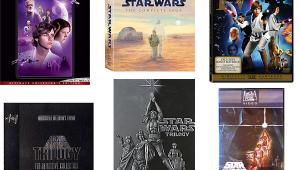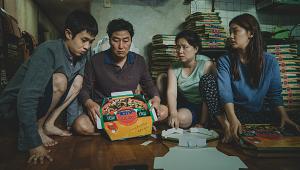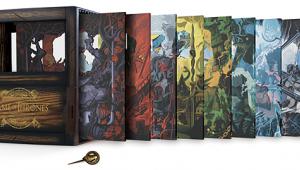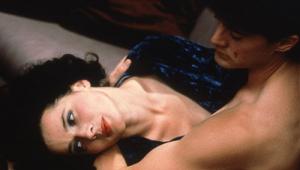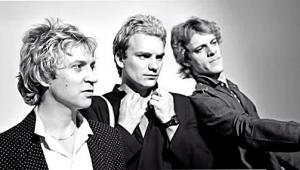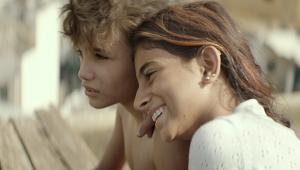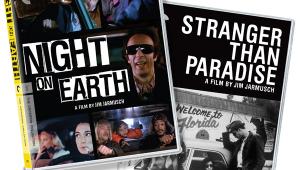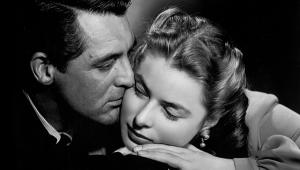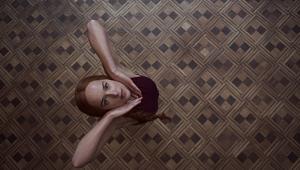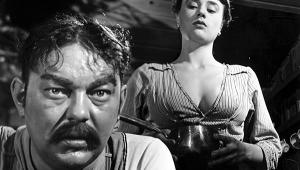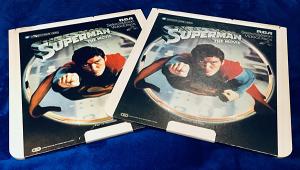Back To The Future: The Complete Trilogy
Back to the Future
Crispin Glover, Claudia Wells. 116 minutes. 1985.
Back to the Future Part II
Elizabeth Shue, Flea. 108 minutes. 1989.
Back to the Future Part III
Mary Steenburgen, Elizabeth Shue, Flea, Harry Carey, Jr., Dub Taylor, Pat Buttram, Richard Dysart. 115 minutes. 1990.
Writer-director Robert Zemeckis and co-writer/producer Bob Gale (aka Bob & Bob) didn't dream of making a sequel to Back to the Future until BTTF I turned out to be the highest-grossing film of 1985. Universal realized the potential size of the franchise they now owned, and the time-travel gimmick gave its creators a unique opportunity to revisit the first film in the second and third, and to add layer on layer of complexity and time paradox. The Back to the Future trilogy is thus not a film and two sequels, but a single tangled story line sometimes told linearly, more often in temporal overlays and doublings-back in time to original events that keep getting revisited, revised, and relived by their original characters in younger, older, alternate, and simultaneous versions of themselves. The results are as compulsively watchable in 2003 as they were in 1985, 1989, and 1990.
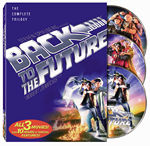 Marty McFly (Michael J. Fox) is an average high school kid whose dad, George (Crispin Glover), is a world-class nerd with the pocket protector to prove it—a corporate wimp bullied by his supervisor, Biff Tannen (Thomas F. Wilson). Marty's mom, Lorraine (Lea Thompson), is a drunk, and his brother and sister seem bound for careers in fast food. Marty's close friend, Doc Brown (Christopher Lloyd), is an eccentric, wild-eyed scientist who fancies himself an inventor. Trouble is, none of Doc's gizmos work . . . except a time machine, which he's built into the chassis of a DeLorean. Boosted by high-grade plutonium and something called a flux capacitor, the car goes into temporal overdrive at precisely 88mph.
Marty McFly (Michael J. Fox) is an average high school kid whose dad, George (Crispin Glover), is a world-class nerd with the pocket protector to prove it—a corporate wimp bullied by his supervisor, Biff Tannen (Thomas F. Wilson). Marty's mom, Lorraine (Lea Thompson), is a drunk, and his brother and sister seem bound for careers in fast food. Marty's close friend, Doc Brown (Christopher Lloyd), is an eccentric, wild-eyed scientist who fancies himself an inventor. Trouble is, none of Doc's gizmos work . . . except a time machine, which he's built into the chassis of a DeLorean. Boosted by high-grade plutonium and something called a flux capacitor, the car goes into temporal overdrive at precisely 88mph.
That list of ingredients could have engendered any number of films, including, in decreasing order of probability: a sci-fi action-adventure, a dystopian vision of a world gone wrong, a buddy movie, a suburban sitcom, a high school romance, tales of a son's love for and rescue and redemption of his father, of a young man and his aging mentor, of middle-aged failure and angst, a multigenerational family saga, a May/September romance, a rip-snortin' Western à la John Ford. Bob & Bob made all of them at once.
The BTTF films have aged well. Partly this is due to the editing, which would be the state of the art in any era, and partly to Zemeckis's insistence on "production sound": that is, as little post-production overdubbing of dialogue, or looping, as possible. More than that, it's the commitment and quality of the acting, particularly the astonishingly supple work of two consummate physical comedians, Michael J. Fox and Christopher Lloyd. Fox never merely runs to a car or climbs a ladder. Rather than run around the DeLorean's hood to get to the door, he gracefully slides across it; rather than climb the ladder he's leaning against, he loops an arm behind him, grasps a rung at the end of his reach, then hoists and twists himself by that one arm around to the other side of the ladder and climbs. Both actions are such smooth ballets of everyday motions that you notice neither till the fourth or fifth viewing. Lloyd based his characterization of Doc Brown on a big-hearted combination of Albert Einstein (hair, basic lack of fashion sense) and conductor Leopold Stokowski (hair, larger-than-life gestures); he delivers his many lines of tongue-twisting, pseudo-scientific exposition at a running shout that is never less than wildly endearing.
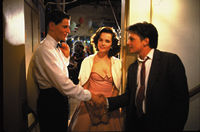 A plot summary would consume the rest of this issue, and anyway, you've already seen these movies. More important is the genuine warmth and affection between Marty/Fox and Doc/Lloyd. This partnership between a teenaged boy and a social misfit who is, variously, 20 and 50 years older, is one of the few convincingly warm and loving relationships between heterosexual males that I've seen in films of the last few decades. And when, in III, it's Doc's turn to be rescued and even to fall in love, the playing field between the two men is satisfyingly leveled.
A plot summary would consume the rest of this issue, and anyway, you've already seen these movies. More important is the genuine warmth and affection between Marty/Fox and Doc/Lloyd. This partnership between a teenaged boy and a social misfit who is, variously, 20 and 50 years older, is one of the few convincingly warm and loving relationships between heterosexual males that I've seen in films of the last few decades. And when, in III, it's Doc's turn to be rescued and even to fall in love, the playing field between the two men is satisfyingly leveled.
Lea Thompson is terrific as four different versions of Marty's mother and his great-great-grandmother, by turns winsome, haggard, and noble. Despite a tendency to chew the scenery along with the horse manure, Thomas F. Wilson is repulsively attractive as four different versions of Biff Tannen, as well as Biff's grandson, Griff, and Biff's great-great-grandfather, Buford "Mad Dog" Tannen. And the best role Crispin Glover ever had was as George McFly in BTTF I (Glover didn't appear in II or III).
Their somewhat frenetic exposition (especially in II) aside, the films are beautifully made. The production values are high, the pre-CGI special effects virtually seamless, the editing so tight it squeaks. Hitchcock said that a moving camera is an emotional camera; Zemeckis and director of photography Dean Cundey's cameras never stand still, constantly creeping, zooming, and panning in complex tracking shots brought off with effortless panache. If, as every film-school student learns, a film's every shot should further plot and character, then these are some of the most well-packed movies ever made. Each frame is crammed with perfectly composed, balanced detail in all three dimensions: side to side, top to bottom, foreground to background. The visions of the past of 1955 and the future of 2015 look convincingly lived-in and livable, two things that period and futuristic films alike often miss. And if "overblown" and "perfectly proportioned" can describe the same orchestral score, then they describe Alan Silvestri's gorgeous music, by turns mock-heroic and earnestly so.
BTTF III is primarily a Western, complete with teams of runaway horses, Monument Valley vistas, an entire Western town, and appearances by three ancient character actors: Harry Carey, Jr., Dub Taylor, and Pat Buttram, wheezing and gasping. A long shot of the spurned Clara—Mary Steenburgen in perhaps the best role of her career—in her purple dress, waiting by the tracks as the steam locomotive chugs into the station straight at the slowly rising camera, is one scene of sheer cinematic gorgeousness in a film that fairly bulges with it. The rich, warm sepia tone seems attained without filters; you can virtually smell all the leather and dust.
Zemeckis, a master of deep-focus composition, shot all three films in 1.85:1, not scope, because he couldn't get the depth of field he wanted with a widescreen anamorphic lens. An example from III: Marty and Doc are at the Hill Valley Depot in 1885, asking if the steam locomotive might be able to hit 88mph. As they examine a map in the foreground, in the middle background behind them we see Clara, whom neither of them has yet met, stepping down from a passenger coach. Meanwhile, from a baggage car in the far background, a crew unloads the immense clock that, brand new here in 1885, is about to be installed in the still-unfinished tower of the Hill Valley Courthouse, so central to the plot and imagery of all three films.
- Log in or register to post comments


